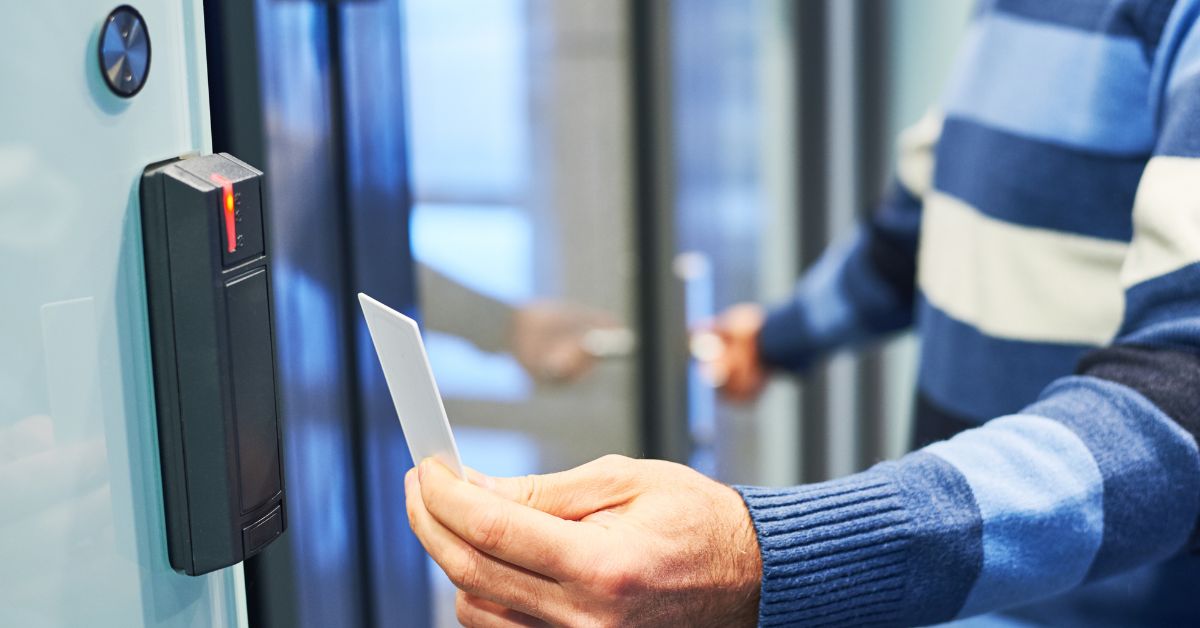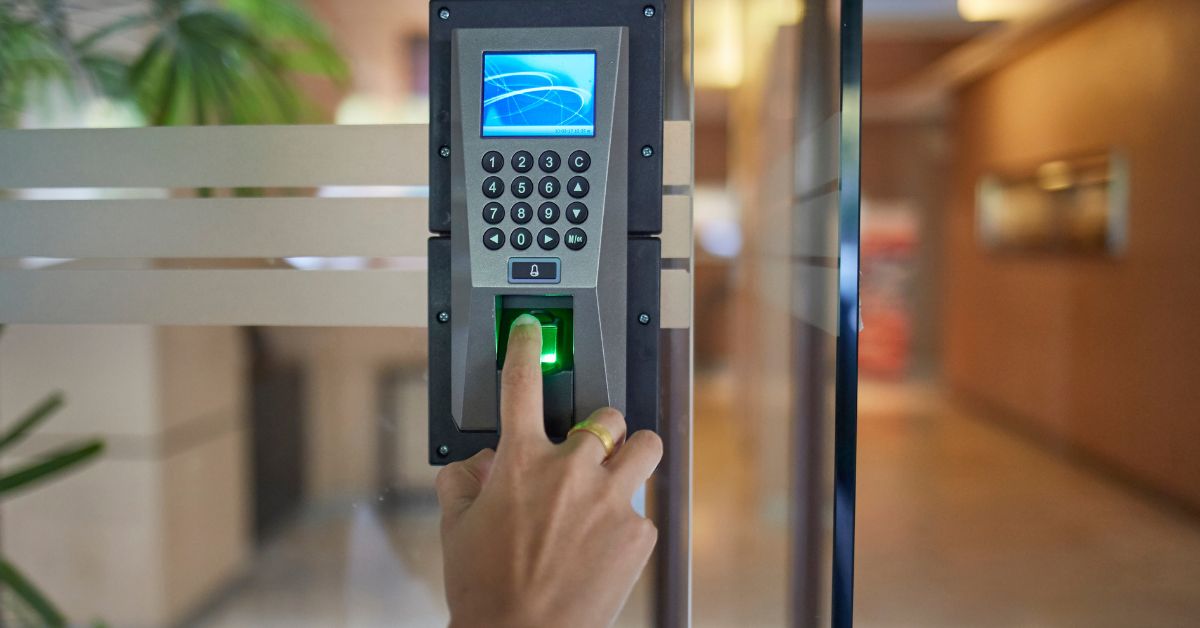A Complete Guide to Electronic Access Control Systems

No matter the size of your business, security is paramount. From small offices to large facilities, electronic access systems provide smarter, more efficient ways to safeguard your business. Whether it’s tracking who enters and leaves your building or eliminating traditional keys that can easily be stolen or copied, these systems are transforming security as we know it.
Wondering how you can implement an electronic access control system for your facility? You’re in luck! We’ve got a complete guide to electronic access control systems to equip you with the knowledge you need to upgrade your business today.
What Is an Electronic Access Control System?
Using digital methods instead of traditional locks and keys, an electronic access control system lets you regulate who has access to specific areas of your building. These systems include components like keycards, fobs, biometrics, and mobile apps to authenticate users and unlock doors.
Unlike typical lock-and-key setups, electric door locks integrate seamlessly with other security measures like surveillance cameras or alarm systems. They log every interaction so you know exactly who entered, where, and when. This level of control is especially vital for businesses and facilities handling sensitive data or valuable assets.
The Benefits of Electronic Access Control Systems
If you’re still relying on traditional locks, it’s time to reconsider. Discover how you can benefit your business by upgrading to an electronic access control system.
Improved Security
Traditional keys can be lost, stolen, or copied, leaving your facility vulnerable. Access control systems eliminate these risks with keycards or biometric authentication, which are harder to duplicate and easier to manage.
Customizable Access Settings
These systems allow you to grant access permissions based on roles, departments, or times of the day. For instance, your employees might need access to the main office during work hours, but only a few should have after-hours access to sensitive areas like server rooms or storage.
Real-Time Monitoring
If you need to know who entered your building at what time, electronic access control systems are your best bet. By providing detailed activity logs, these systems help you stay in control. If an incident occurs, you can quickly locate potential culprits or suspicious activity.
Scalability
Whether you operate a single office or multiple locations, electronic access systems grow with you. As your business evolves, you can easily add new users or expand coverage to additional doors.
Cost Efficiency
Although the upfront costs may seem high, these systems save money long term. Forget about rekeying locks whenever someone misplaces a key or leaves the company. Instead, you simply deactivate the individual’s credentials.

Types of Electronic Access Control Systems
Now that you know their benefits, let’s explore the different types of systems. Depending on your organization’s needs, one may stand out over the others.
Keycard and Key Fob Systems
Both widely used and user-friendly, these systems require that employees carry a keycard or fob to scan at a reader to unlock a door. Though this method works great for day-to-day employees, it may not be suitable for high-security zones due to the risk of lost or stolen cards.
Biometric Access Systems
Want enhanced security? Biometric systems use unique identifiers like fingerprints, facial recognition, or even iris scans. They’re perfect for businesses that handle sensitive information or require a high level of control.
Mobile-Based Access Systems
Today’s employees are more likely to forget their ID card than their smartphones, so consider using a mobile-based system so users can unlock doors with an app. These systems are highly convenient and reduce reliance on physical objects.
PIN Code Systems
PIN pad systems are another cost-effective option, allowing users to enter a numeric code to gain access. While PIN code systems are practical, you must remember to regularly update PIN codes to reduce the risk of unauthorized access.
Cloud-Based Systems
If managing access for several locations sounds daunting, a cloud-based system could come in handy. Manage permissions, update credentials, and monitor activity logs in real-time from anywhere. This option is highly flexible and perfect for growing businesses.
Key Features To Look For in an Access Control System
When choosing a system, focus on features that will serve your unique needs. Below are the top priorities you should keep in mind.
Integration Capabilities
Does the system work with your existing security devices like surveillance cameras or intercoms? Integration simplifies overall management while improving security.
User-Friendly Interface
A complicated system won’t do you any favors, so look for intuitive software or apps that make managing permissions and monitoring activity straightforward.
Multi-Factor Authentication (MFA)
For high-risk areas, add an extra layer of protection by using systems that incorporate multi-factor authentication like a combination of biometrics and PIN codes.
Remote Access
For maximum mobility, go for cloud-enabled systems with remote access. This allows you to manage everything from a smartphone or web portal.
Real-Time Alerts
Some systems send immediate notifications for unusual activity, such as someone trying to gain access after-hours. These alerts help you respond quickly to potential threats.

How To Choose the Right Access Control System for Your Business
To decide on the right system for you, make sure to follow these essential steps:
Step 1: Assess Your Needs
Start with a detailed evaluation. Consider your facility size, the number of employees, and specific security risks. Identify areas requiring various levels of access control.
Step 2: Consult Professionals
Access control systems aren’t one-size-fits-all, so reach out to security experts or vendors who can give recommendations tailored to your needs.
Step 3: Compare Costs
While on-premise systems may have higher upfront costs, cloud-based systems often come with lower initial fees but sometimes require ongoing subscription expenses. Based on your budget, be sure to weigh both options.
Step 4: Look for Scalability
Is your business growing? Plan for scalability by choosing systems that can accommodate more users, doors, or locations without major upgrades.
Step 5: Test the System
Request a demo or trial run before finalizing your purchase. By testing your system, you verify that it meets your needs before you make a purchase.
Step 6: Plan Training and Maintenance
Once the system is in place, train your staff on how to use it effectively. Also, implement a regular maintenance schedule to keep your system running smoothly over time.
Elevate Your Security With Electronic Access Control
Proper security measures will help you mitigate threats while creating trust and peace of mind for everyone involved in your business. With this complete guide to electronic access control systems, you have the information you need to make necessary changes that will boost security and streamline operations.
Don’t wait until something happens to reevaluate your security. Start exploring electronic access control solutions at DoorHub to provide your business with the protection it deserves.

Author
Michael Rega
Chief Marketing Officer and founding Member of DoorHub.com